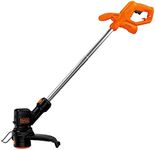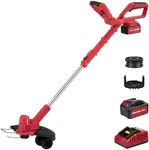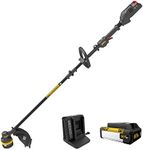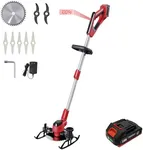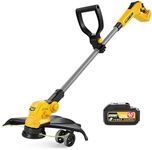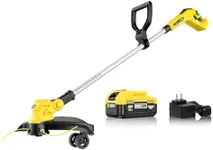Buying Guide for the Best Corded Electric Weed Eaters
Choosing the right corded electric weed eater can make your yard work much easier and more efficient. These tools are great for trimming grass and weeds in areas where a lawnmower can't reach. When selecting a corded electric weed eater, it's important to consider several key specifications to ensure you get the best fit for your needs. Understanding these specs will help you make an informed decision and find a model that suits your yard size, type of vegetation, and personal preferences.Power (Amps)The power of a corded electric weed eater is measured in amps. This spec indicates how much electrical current the motor can handle, which directly affects the tool's cutting performance. Higher amp ratings generally mean more powerful motors that can tackle thicker and tougher weeds. For small to medium yards with light vegetation, a weed eater with 5-7 amps should suffice. For larger yards or areas with dense, tough weeds, consider models with 8-10 amps or more.
Cutting WidthCutting width refers to the diameter of the area the weed eater can trim in one pass. This spec is important because it affects how quickly you can complete your trimming tasks. Smaller cutting widths (10-12 inches) are suitable for precision work and tight spaces, while larger cutting widths (13-15 inches) are better for covering more ground quickly. Choose a cutting width based on the size of your yard and the type of trimming you need to do.
WeightThe weight of the weed eater is crucial for ease of use and comfort during extended periods of trimming. Lighter models (5-7 pounds) are easier to handle and maneuver, making them ideal for smaller yards or users who may have difficulty with heavier tools. Heavier models (8-10 pounds) might offer more power but can be tiring to use for long periods. Consider your physical strength and the duration of your typical yard work when choosing the weight of your weed eater.
Shaft TypeCorded electric weed eaters come with either straight or curved shafts. Straight shafts are generally longer and provide better reach for trimming under bushes and in hard-to-reach areas. Curved shafts are shorter and offer better balance and control, making them easier to handle for most users. If you need to trim in tight spaces or prefer a lighter tool, a curved shaft might be the best choice. For more versatility and reach, opt for a straight shaft.
Line Feed SystemThe line feed system determines how the cutting line is advanced during use. There are three main types: bump feed, automatic feed, and fixed line. Bump feed systems require you to tap the head on the ground to advance the line, offering control but requiring manual effort. Automatic feed systems advance the line automatically, providing convenience but potentially less control. Fixed line systems use pre-cut lengths of line, which can be easier to replace but may require more frequent changes. Choose a line feed system based on your preference for convenience and control.
ErgonomicsErgonomics refers to the design features that make the weed eater comfortable and easy to use. Look for adjustable handles, padded grips, and balanced weight distribution to reduce strain and fatigue during use. Good ergonomics are especially important if you plan to use the weed eater for extended periods. Consider your comfort and any physical limitations when evaluating the ergonomic features of different models.



